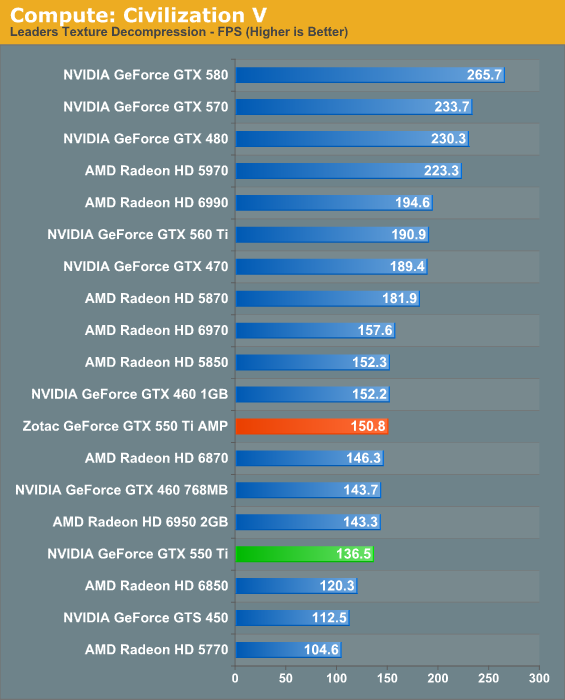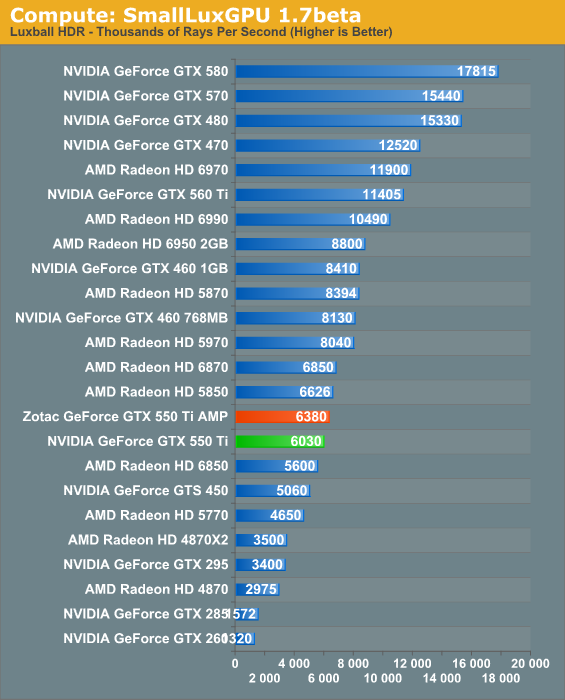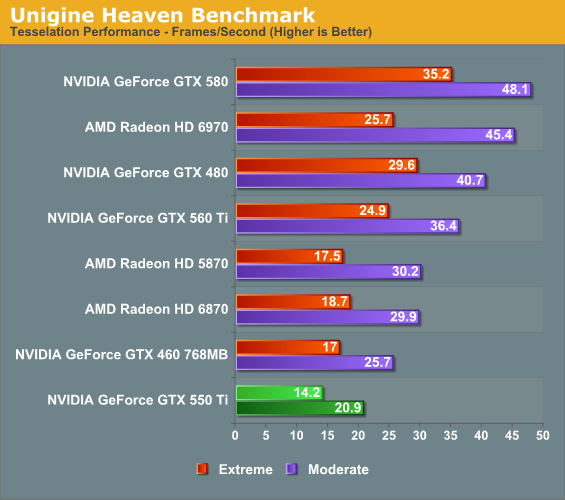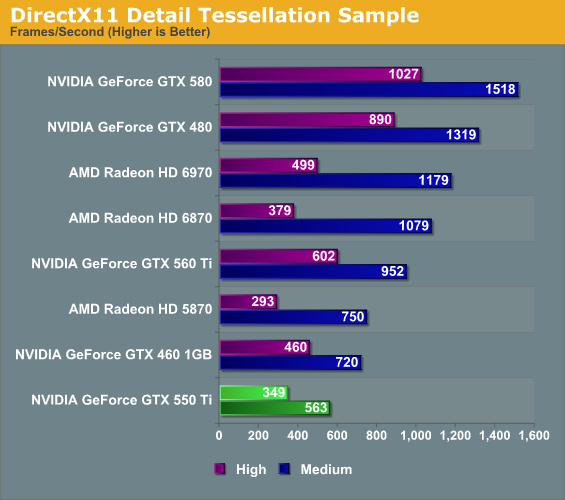NVIDIA's GeForce GTX 550 Ti: Coming Up Short At $150
by Ryan Smith on March 15, 2011 9:00 AM ESTCompute & Tessellation
Moving on from our look at gaming performance, we have our customary look at compute performance, bundled with a look at theoretical tessellation performance.
Our first compute benchmark comes from Civilization V, which uses DirectCompute to decompress textures on the fly. Civ V includes a sub-benchmark that exclusively tests the speed of their texture decompression algorithm by repeatedly decompressing the textures required for one of the game’s leader scenes.

Unlike our gaming benchmarks, Civ V’s compute performance strongly favors NVIDIA’s Fermi family here, giving the GTX 550 a very strong showing. At 136fps it’s competitive with the much more expensive 6950 and even comes quite close to the GTX 460 768MB. The 6850 and 5770 meanwhile fall well behind.
What’s quite interesting is that with a bit more gas, the Zotac AMP really climbs up the charts. At 150fps it’s tailing the GTX 460 1GB and even AMD’s single-GPU king, the 6970. And ultimately while this benchmark is compute bound, it’s also memory bound at least part of the time, which is why the GTX 550 outperforms the GTS 450 by 21%.
Our second GPU compute benchmark is SmallLuxGPU, the GPU ray tracing branch of the open source LuxRender renderer. While it’s still in beta, SmallLuxGPU recently hit a milestone by implementing a complete ray tracing engine in OpenCL, allowing them to fully offload the process to the GPU. It’s this ray tracing engine we’re testing.

SmallLuxGPU also gives NVIDIA a solid standing here, however not quite as much as with Civ V. The GTX 550 beats the 5770 and even pulls ahead of the 6850 here. The benefit from the memory bandwidth increase is minimal however, leading to a lower 15% gain versus the GTS 450, and a larger 25% gap versus the GTX 460.
Our final compute benchmark is a Folding @ Home benchmark. Given NVIDIA’s focus on compute for Fermi, cards such as the GTX 560 Ti can be particularly interesting for distributed computing enthusiasts, who are usually looking for a compute card first and a gaming card second.

We do not normally classify Folding@Home to be very memory bandwidth sensitive on GPUs, which makes our results here more interesting than we expected. A 17% gain over the GTS 450 is in-line with the core clock increase, but achieving 81% of the GTX 460 is no small feat. With the AMP’s overclock, the card closes to within 10% of the GTX 460.
At the other end of the spectrum from GPU computing performance is GPU tessellation performance, used exclusively for graphical purposes. With Fermi NVIDIA bet heavily on tessellation, and as a result they do very well at very high tessellation factors. With 1 GPCs the GTX 560 Ti can only retire 1 triangle/clock however, which nullifies much of the architectural advantage on paper.

Even with extreme levels of tessellation, the lower geometry throughput of the GTX 550 keeps a lid on performance. It’s consistently around 80% of the performance of the GTX 460, however the hit for using extreme tessellation ultimately is greater here than on NVIDIA cards with more geometry throughput. As NVIDIA likes to note it has quite a bit more geometry throughput than older generation cards, but tying geometry performance to the number of SMs means parity between high and low-end cards is lost.

The DX11 Detail Tessellation sample reinforces those findings. NVIDIA does keep up their solid scaling from medium to high tessellation versus AMD though., including a very surprising score versus the 5870 and 6870 at high tessellation.










79 Comments
View All Comments
dmans - Tuesday, March 15, 2011 - link
my 8800 gt is better than this thing.mapesdhs - Tuesday, March 15, 2011 - link
Google for, "Ian PC tests", it's the 1st link that comes back. Scroll down the page
for the full list of results pages (I've done a whlole bunch). Voila, a mountain of
8800GT data for you to chew on. 8-) And much more to add!
Ian.
HangFire - Wednesday, March 16, 2011 - link
"lan PC tests". Hmm. I get a reviews.cnet.com link for a WiFi antenna.And, can you please stop spamming the comments?
mapesdhs - Wednesday, March 16, 2011 - link
I'm not spamming the comments, I'm providing real info to help people
out. Re the Google, it could be because being in the UK I'm forced
to use google.co.uk which may give different results to google.com
(probably does). Alas, nothing I can do about that (hmm, "try, "Ian SGI
UK" instead, that should bring up the right link). If you want to know
what I'm talking about though, send me a PM and I'll send you the refs
so you can see what I mean. People keep asking upgrade questions
which review articles do not or cannot answer, eg. those playing
older games, at lesser resolutions, with systems that don't have uber
CPUs, etc.. I've been working to provide the info that answers such
questions (have you?). That isn't spamming.
Ian.
HangFire - Wednesday, March 16, 2011 - link
>my 8800 gt is better than this thing.That would make it faster than the GTX260 as well. That's some 8800GT!
I love the value that my 8800GT provided, but it is sitting on the shelf now for a reason.
sheh - Tuesday, March 15, 2011 - link
I'm not one to comment on this sort of things in general but I must in this case. Each instance of "in to" in the graphics hardware articles comes with a mental dissonance I have to resolve before reading can be resumed.http://www.wsu.edu/~brians/errors/into.html
http://data.grammarbook.com/blog/definitions/into-...
Other than that, keep up the good work. :)
gammaray - Tuesday, March 15, 2011 - link
I don't understand the logic behind the pricing of video cards nowadays.Low end video cards like this new 550ti should be below 100$
mid range video cards 150ish and
high end 200-250$ MAXIMUM
mapesdhs - Tuesday, March 15, 2011 - link
An item is only ever worth what someone is willing to pay.
There are those with big budgets who are happy to pay $600+, hence products
to match such affordability exist and always will do.
If you had something to sell, would you let someone buy it for $200 if you had
a different customer who was happy to pay you $400? ;)
Such is the law of supply & demand. I deal with this every day with respect to
buying/selling used SGI items. Hobbyists assume old items should be cheap
because they're old and they don't want to pay much, but in reality commercial
demand for certain items extremely strong, so the real value is sometimes very
high. Same basic concept applies to anything really. A brand of chocolate
cookies my gf & I particularly like have gone up in price recently by quite a lot,
and I'm sure it's because they are popular. Demand rise = price rise.
In some parts of the world, the market for high-end consumers GPUs is quite strong.
Ian.
Will Robinson - Wednesday, March 16, 2011 - link
What a shame to soil the good reputation of past and present Ti cards on this dud.Belard - Wednesday, March 16, 2011 - link
"TI" is meaningless. Might as well mean "Total Idiot".If they took out the "TI", it would still be the same product. Its all marketing to get people to remember about the old $200 kick-ass 4200~4600 cards... before the GF 5800 debacle.
TI originally was about its manufacturing (so they say), but look back. There were no 4200 and 4200 TI, right? They divide the GF2-tech cards into 4x0MX and the state of the art into 4x00TI.
We'll soon see the return of MX, PRO and Ultras I think... hell, maybe even the "Geforce GTX ti 785 Ultra TNT" in 2012.